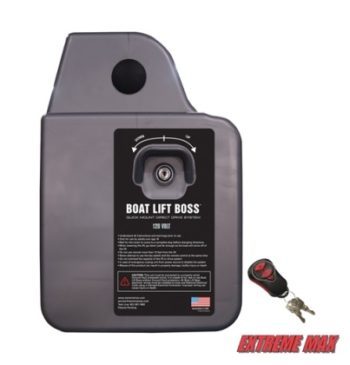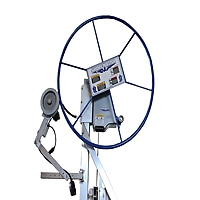USED BOAT LIFT BUYING GUIDE
This Used Boat Lift Buying Guide covers everything you need to know about buying a used boat lift. Avoid added costs. This two-part series will guide you through everything you need to know and what to look for.
There are four main areas to investigate – the frames, the pulley system, and the cables. This article will cover:
- Framework,
- Pulley system,
- Motor setup (if equipped), and
- Rated boat lift capacity vs. your boat weight.
We discuss four more items in Part 2 later this week.
Here’s a list of things to check:
- Are the frames sturdy?
- Do the pulleys have signs of wear or damage?
- Does the motor (if any) operate properly?
- Is the lift appropriately sized for the boat?
ARE THE FRAMES STURDY?
With the lift sitting firmly on the ground, push the upright posts sideways. All frames will move somewhat. If the movement seems excessive, check the bottom diagonal braces near the lower frame carefully. If the structure continues to move after you release it, check all the connections at the bottom thoroughly.
Is the frame moving where the upright posts attach to the bottom frame? If the answer is yes, examine the brace connections and all bolt to see if the bolts are loose or are the holes elongated.
If the drilled holes become elongated, this is a problem. You may have to drill a slightly larger hole and use a different bolt diameter to firm up the connection. NOTE: NEVER DRILL INTO THE LIFT RACK!
If one end of the brace has a slot, make sure the bolt is tight.
Are ALL The bolts tight where the frames connect?
Do the pulleys have visible signs of wear or damage?
The pulley location is in each corner of the boat lift “rack.” The rack is the part of the lift that moves up and down with your boat on it.
Some corners will have one pulley, and others will have two pulleys. If it’s a Shoremaster boat lift, there will never be a problem with broken pulleys. You will never have to replace a brass pulley.
Most brands use hard, black plastic for the pulley. Despite using UV inhibitors in the pulley material, the plastic tends to become brittle with time. When the pulley breaks, it usually involves a part of one side of the pulley groove breaking off.
With one side broken out, the cable jumps out of the groove. When this happens, the rack, especially with the weight of the boat on it, will become VERY difficult to move.
In a single pulley location, the cable drops down onto a bolt and drags across the surface of the bolt. Over time the lift cable will break, or the bolt will wear through and snap.
To check for this condition observe the pulleys at each corner as the rack moves up and down. Check to see if a flange has broken off around the perimeter of each pulley. A broken pulley can be an expensive repair.
Is the cable dragging across a bolt? Are any pulleys frozen in place?
Is there debris (seaweed, reeds, or sand) packed around the pulleys? Remove all the waste to free the cables and pulleys. Even sand can pack so tightly in the tubes that the pulleys will not turn.
DOES THE MOTOR OPERATE CORRECTLY? (If equipped)
With two basic configurations, boat lift motors will save you from sore muscles. Even a child can raise your boat with a boat lift motor. Both types of motor operate by solar energy or electricity. We highly recommend the solar (D.C.) operated models for obvious reasons.
The best and most dependable type is the Lift Boss brand by Extreme Max. Lift motors come in various shapes, but the Lift Boss has a protective housing around it. The large wheel comes off the lift.
There are three ways to operate the motor – turn-key, pendent, or wireless remote control. You can’t beat the convenience of the wireless remote. Would you physically open your garage door each time? Remember, a boat weighs a lot more than a garage door.
The second version is a friction wheel type. You lease the large lift wheel in place and mount the motor to the lift upright. It operates by friction against the larger wheel.
There are two problems with this type. The rubber wheel can become smooth and hard, requiring replacement. A hard or smooth wheel reduces the amount of friction developed by the wheel, causing it to slip.
The second problem is when there is dew on the wheel in the early morning hours or after a rain. Moisture between the two wheels reduces the friction needed to operate. The small wheel slips and will not turn the larger wheel.
DOES THE USED BOAT LIFT HAVE THE CAPACITY FOR YOUR BOAT?
That’s simple, isn’t it? After all, the manual says the boat weighs 2,000# and is 95″ wide.
But does it weigh 2,000#? The best thing you can do is read this article. You will be amazed by what a typical 2,000# boat could weigh when placed on a boat lift.
These are the first four things to check. Later this week, we will explain number 5 through 9.
Tell Your Friends & Family
Have friends or neighbors you believe should see this article? Email them this link for the Used boat lift buying guide – and Thank you!
Also, visit Pier & Waterfront Solutions on Facebook.
Don’t Forget – Considering rip-rap for your shoreline? PWS is the place to contact!
Where is Pier & Waterfront Solutions?
ARE WE OPEN?
During this time of uncertainty, Pier & Waterfront Solutions is staying “open.” We have implemented measures to ensure the safety of our employees and visitors. At the same time, we are working to maintain the trusted service that you have come to expect.
We are implementing these precautionary measures:
- Conducting as much business as possible by email, text, or phone.
- Site visits will continue but with limited in-person meetings.
- When in-person contacts are necessary, we will follow “social distancing” guidelines.
- Our display yard is always open for you to examine at your leisure. All displays have a numbered, red tag on them. If you want more information or pricing, please reference that number.
Is there More?
- Some employees will be working remotely, but they are always available by phone.
- Any employee with symptoms or illness is sent home.
- We continue to provide estimates and invoices by email to make the process paperless.
- Crew starting times are being staggered to limit social interactions.
- We keep the same crews together to limit cross interactions.
With these measures, we hope everyone will stay safe, and we will be back to normal operations soon.
What can YOU do to help us?
- Please conduct as much business as possible via emails, messaging, and emails. This step protects everyone involved.
- When you see our crews installing equipment, please practice “social distancing.”
Thank you for allowing us to work with you.
So – YES – WE ARE OPEN!
Please call, message, or email us with any questions.
Let’s all stay safe!
Contact:
Jerry @ (920) 493-4404 or Jerry@wisconsinpws.com – Commercial work & new/used Sales.
Dave @ (920) 905-2588 or Dave@wisconsinpws.com – Erosion control & shoreline work.
John @ (920) 493-4405 or John@wisconsinpws.com – Scheduling & Service work







